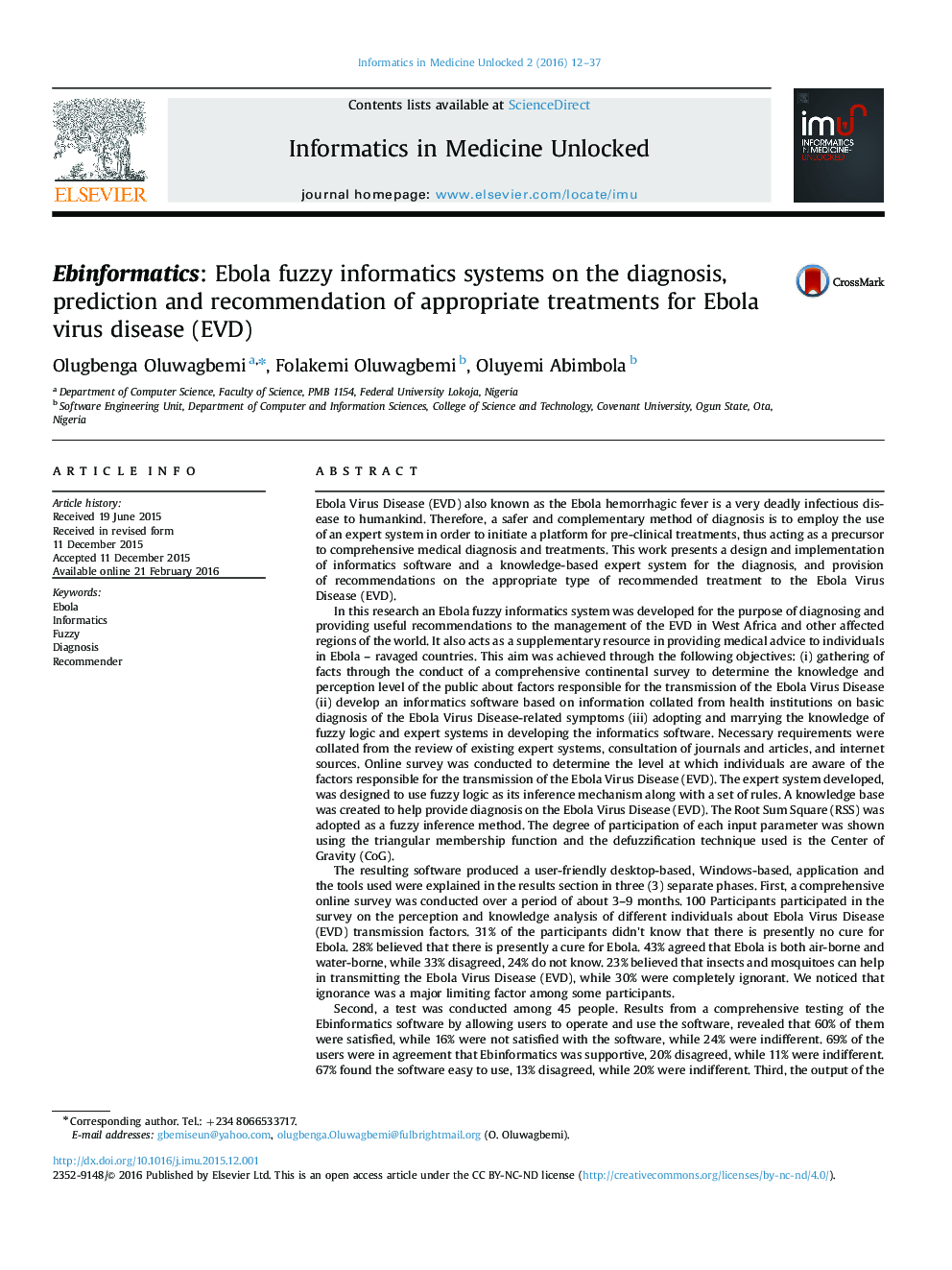| کد مقاله | کد نشریه | سال انتشار | مقاله انگلیسی | نسخه تمام متن |
|---|---|---|---|---|
| 483478 | 701411 | 2016 | 26 صفحه PDF | دانلود رایگان |
Ebola Virus Disease (EVD) also known as the Ebola hemorrhagic fever is a very deadly infectious disease to humankind. Therefore, a safer and complementary method of diagnosis is to employ the use of an expert system in order to initiate a platform for pre-clinical treatments, thus acting as a precursor to comprehensive medical diagnosis and treatments. This work presents a design and implementation of informatics software and a knowledge-based expert system for the diagnosis, and provision of recommendations on the appropriate type of recommended treatment to the Ebola Virus Disease (EVD).In this research an Ebola fuzzy informatics system was developed for the purpose of diagnosing and providing useful recommendations to the management of the EVD in West Africa and other affected regions of the world. It also acts as a supplementary resource in providing medical advice to individuals in Ebola – ravaged countries. This aim was achieved through the following objectives: (i) gathering of facts through the conduct of a comprehensive continental survey to determine the knowledge and perception level of the public about factors responsible for the transmission of the Ebola Virus Disease (ii) develop an informatics software based on information collated from health institutions on basic diagnosis of the Ebola Virus Disease-related symptoms (iii) adopting and marrying the knowledge of fuzzy logic and expert systems in developing the informatics software. Necessary requirements were collated from the review of existing expert systems, consultation of journals and articles, and internet sources. Online survey was conducted to determine the level at which individuals are aware of the factors responsible for the transmission of the Ebola Virus Disease (EVD). The expert system developed, was designed to use fuzzy logic as its inference mechanism along with a set of rules. A knowledge base was created to help provide diagnosis on the Ebola Virus Disease (EVD). The Root Sum Square (RSS) was adopted as a fuzzy inference method. The degree of participation of each input parameter was shown using the triangular membership function and the defuzzification technique used is the Center of Gravity (CoG).The resulting software produced a user-friendly desktop-based, Windows-based, application and the tools used were explained in the results section in three (3) separate phases. First, a comprehensive online survey was conducted over a period of about 3–9 months. 100 Participants participated in the survey on the perception and knowledge analysis of different individuals about Ebola Virus Disease (EVD) transmission factors. 31% of the participants didn't know that there is presently no cure for Ebola. 28% believed that there is presently a cure for Ebola. 43% agreed that Ebola is both air-borne and water-borne, while 33% disagreed, 24% do not know. 23% believed that insects and mosquitoes can help in transmitting the Ebola Virus Disease (EVD), while 30% were completely ignorant. We noticed that ignorance was a major limiting factor among some participants.Second, a test was conducted among 45 people. Results from a comprehensive testing of the Ebinformatics software by allowing users to operate and use the software, revealed that 60% of them were satisfied, while 16% were not satisfied with the software, while 24% were indifferent. 69% of the users were in agreement that Ebinformatics was supportive, 20% disagreed, while 11% were indifferent. 67% found the software easy to use, 13% disagreed, while 20% were indifferent. Third, the output of the software, showing the various diagnosis and recommendations interfaces were presented. Recommendations were also given with respect to how the system can be extended, and further improved upon.
Figure optionsDownload as PowerPoint slide
Journal: Informatics in Medicine Unlocked - Volume 2, 2016, Pages 12–37
